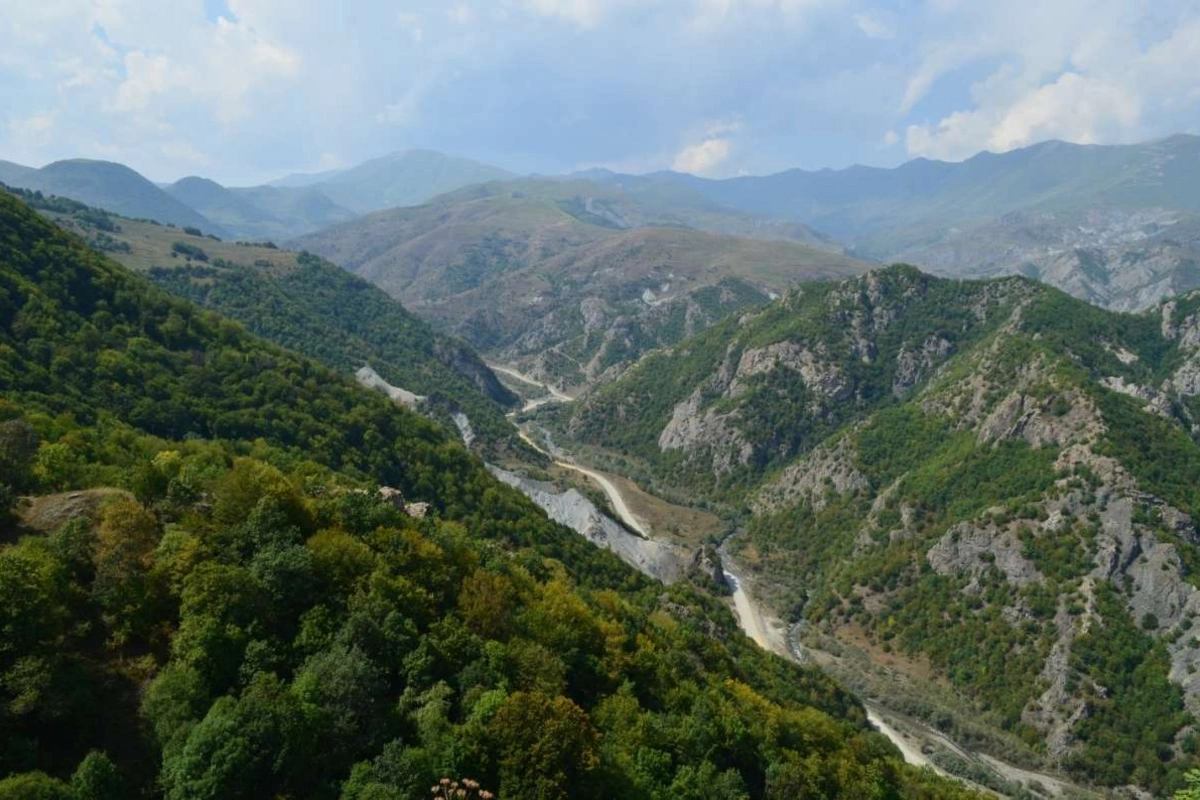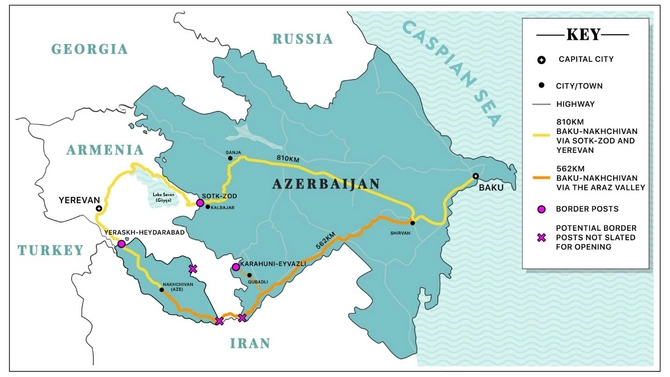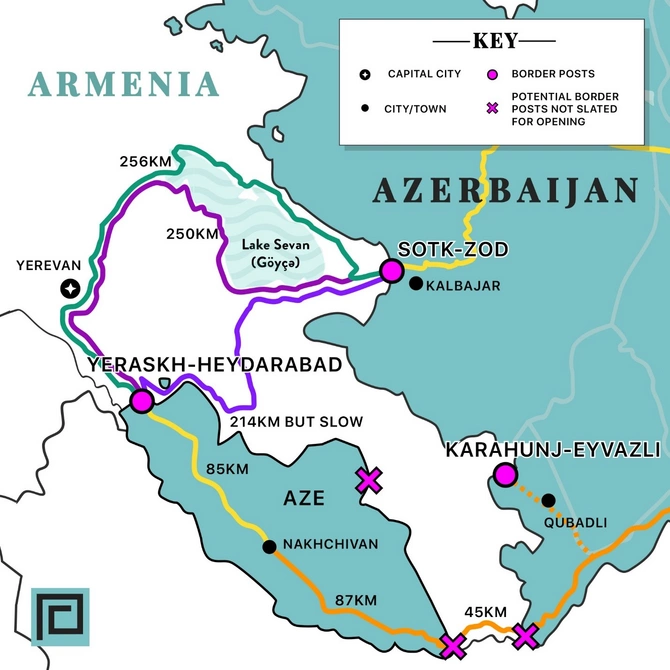
If both sides step back from semantic arguments, a solution for opening Armenia-Azerbaijan borders could be within reach.
Image: Sonashen/ Wikimedia Commons
“When is a road not a road? When it’s a corridor.” Scratch that. Geopolitical jokes never work, and this one isn’t quite right anyway. However, the semantics of roads and corridors are of great importance, particularly when finding a lasting solution to the Armenia-Azerbaijan conflict.
The Caspian Post has already examined the issue of the Lachin Corridor in some detail, mainly focusing on Baku’s high-profile engineering efforts to re-route access to Armenia for Karabakh Armenians via a new road completed earlier this summer. However, it’s worth reiterating the underlying point, which is that the ‘corridor,’ by the old Lachin-Zabukh route or the road via the new highway, implies a means of unobstructed passage between Armenia and Khankendi (known as Stepanakert to Armenians) and the area of Azerbaijan in which Armenians live. The maintenance of such a corridor, at least in the medium term, was specified as article 6 of the Russian-sponsored agreement that ended the 2020 Second Karabakh War. From Baku’s point of view, the costly construction of a new highway to re-route the Lachin Corridor shows a solid commitment to that peace process. However, at the same time, Azerbaijan expects a similarly unobstructed land route to its exclave of Nakhchivan, geographically disconnected from the rest of Azerbaijan by the southern tail of Armenia. Armenia calls this land Syunik, and Azerbaijan calls it Zangezur.
Article 9 of the same November 9, 2020 agreement states:
All economic and transport connections in the region shall be unblocked. The Republic of Armenia shall guarantee the security of transport connections between the western regions of the Republic of Azerbaijan and the Nakhchivan Autonomous Republic in order to arrange unobstructed movement of persons, vehicles and cargo in both directions. The Border Guard Service of the Russian Federal Security Service shall be responsible for overseeing the transport connections.
So in principle, the “unobstructed” travel between Nakhchivan and the rest of Azerbaijan is similarly enshrined. Baku is keen that, as a quid pro quo for the Lachin Corridor (or its replacement), there should be a “Zangezur Corridor” – a term used with some regularity by Azerbaijan’s President Ilham Aliyev. But it’s here that the semantics get tricky. The word “corridor” does not explicitly appear in the 2020 agreement, and Armenia pushes back against any “corridor” idea. In various public comments, Armenian PM Nikol Pashinyan refers specifically to the lack of the word ‘corridor’ in article 9, instead stressing that “all transport and economic communications should be reopened in the region.”

More recently, Yerevan suggested that it has been considering opening three border posts with Azerbaijan, an idea the Armenian press claims would provide the “possibility of transit from Azerbaijan to Armenia.” That sounds encouraging until one considers the details of which border posts are being considered for opening. These are:
1. Sotk-Zod near the controversial gold mine
2. Yeraskh-Heydarabad, in far north-western Nakhchivan
3. Karahunj-Eyvazli, on Armenia’s north-south M2
None of these provide access to the most direct, logical route that would allow transport into Nakhchivan from the east along the Araz Valley, a route by which Nakhchivan City is a little more than 560km from Baku. Indeed, the only border post with Nakhchivan mentioned at all is at Yeraskh-Heydarabad, the very furthest point west in the Nakhchivan exclave. That might look a reasonable second-best on a small-scale map but on the fastest possible route using existing roads, that adds an extra 250km, including a 3½ hour transit across central Armenia (810km total). Slightly shorter routes exist via Martuni (804km via the western side of Lake Sevan/Goycha or 768km via Areni), but these are actually slower. Meanwhile, once you get a better map and look at the contour lines, it’s evident that all such routes cross a major mountain pass instead of taking a mostly lowland route that’s relatively flat most of the way. It’s an absurd choice from a practical standpoint to demand that traffic from Baku takes the far more difficult mountain roads via Goygol towards Kelbajar, then after the border point at Zod/Sotk, goes right across central Armenia before doubling back to reach Nakhchivan City.
It is also vastly less convenient for residents in that it passes through numerous Armenian towns and villages, far more than would be the case if transiting the Araz Valley.
The third border opening suggestion at Karahunj-Eyvazli is something of a red herring in this discussion. A legacy of Soviet-era map-madness, the ruins of Azerbaijan’s Eyvazli village lie essentially disconnected from Azerbaijan, where a 2km loop of Armenia’s M2 briefly crosses then re-crosses the border. Azerbaijan has built a basic road to the Eyvazli site from Qubadli, but that is a narrow, minor lane and no more convenient for reaching Yeraskh-Heydarabad than the larger roads via Zod-Sokt.

All in all, it’s hard to argue that opening the three specific border posts proposed by Armenia could render transit between Nakhchivan and the rest of Azerbaijan truly unimpeded as per the 2020 agreement.[1] Yet, once again, on October 17, Pashinyan tweeted about the issue, creating the impression that Yerevan had made a significant offer to which Baku had failed to respond. Seen in context, however, it’s clear that Azerbaijan would not consider the three border crossing suggestions as a meaningful proposal.
However, perhaps it’s just a way for Yerevan to test the waters politically at home: even this limited opening proposal has received less than glowing praise in Armenia.
Let’s step back a little: to a neutral outside observer, it seems fairly obvious that there is room for a workable compromise. Azerbaijan’s desire for a full-blown “corridor” across Armenia is not really practicable, as was reasonably clear to those drafting the 2020 agreement. The geographical realities mean that the route between Armenia and Khankendi goes through essentially unpopulated land, so even though it essentially slices the Lachin region in two, a route there doesn’t have a particularly harsh economic effect. Making a “corridor” similar to what existed previously in Lachin across Armenia, however, would be a significantly different proposition. If created as a total exclusion zone across the country's southern edge, it could cut off Armenia from Iran, its southern neighbour and an important trading partner.
A more imaginative solution would appear to be a road, somewhat akin to the highway that once linked West Berlin to West Germany – a raised highway above Armenian territory with border posts at any exit ramps into Armenia proper. This is technically more complex and Azerbaijan might eventually impose a similar condition on the road passing through its sovereign territory, i.e. Lachin.
However, proposals along such lines would at least allow the “unobstructed movement” to Nakhchivan as enshrined in article 9 of the 2020 agreement and needn’t be called a “corridor,” thereby saving face for Armenian politicians while passing over (or under) Armenia’s trade route to Iran. What is needed is for both sides to ease up on the semantics and find a solution that is practicable for all involved.
[1] After the October 6 quadrilateral Az-Arm meeting in Prague, President Aliyev regretted that the Zangezur corridor had not featured in the agreement but accepted that it might just require patience.
Share on social media